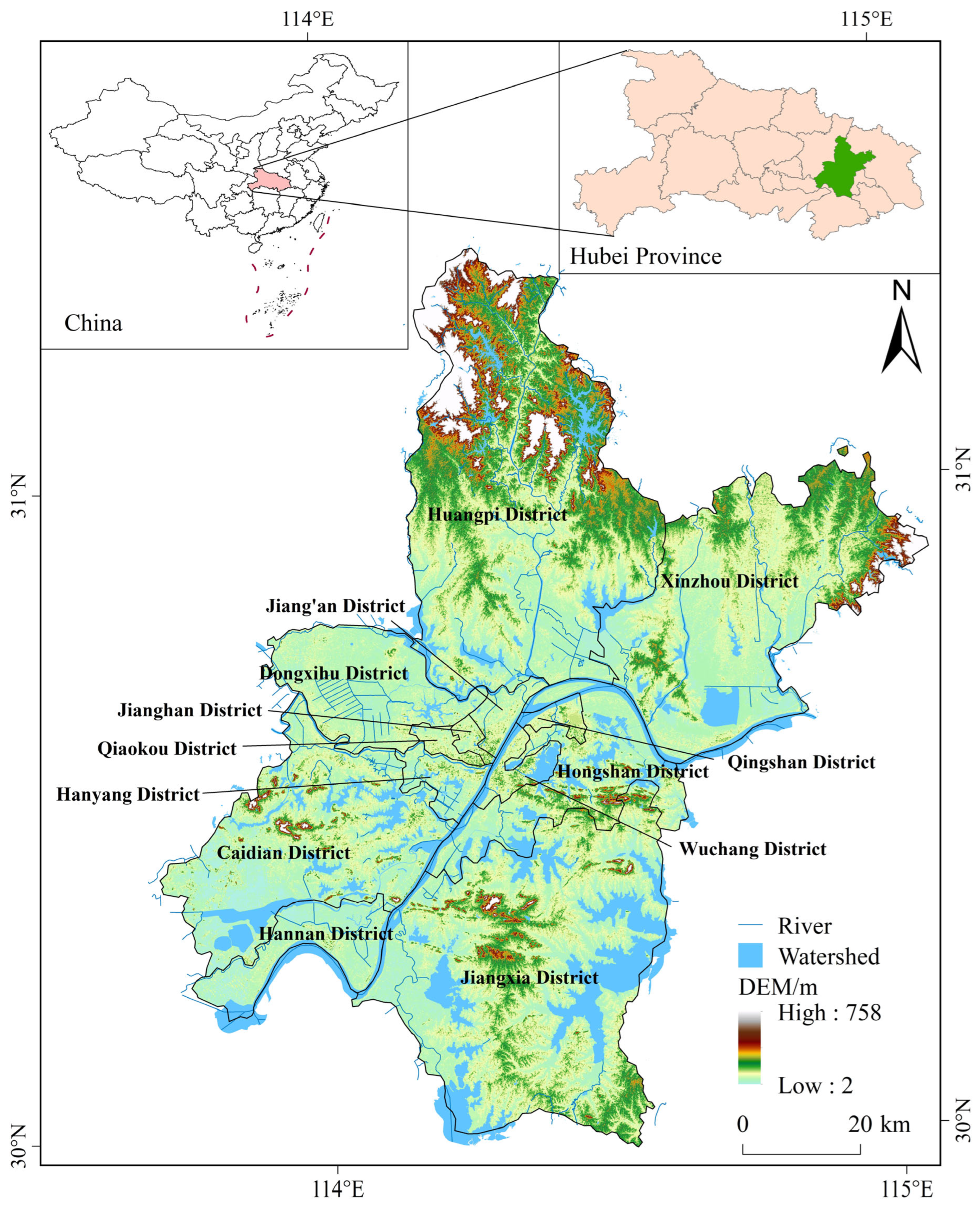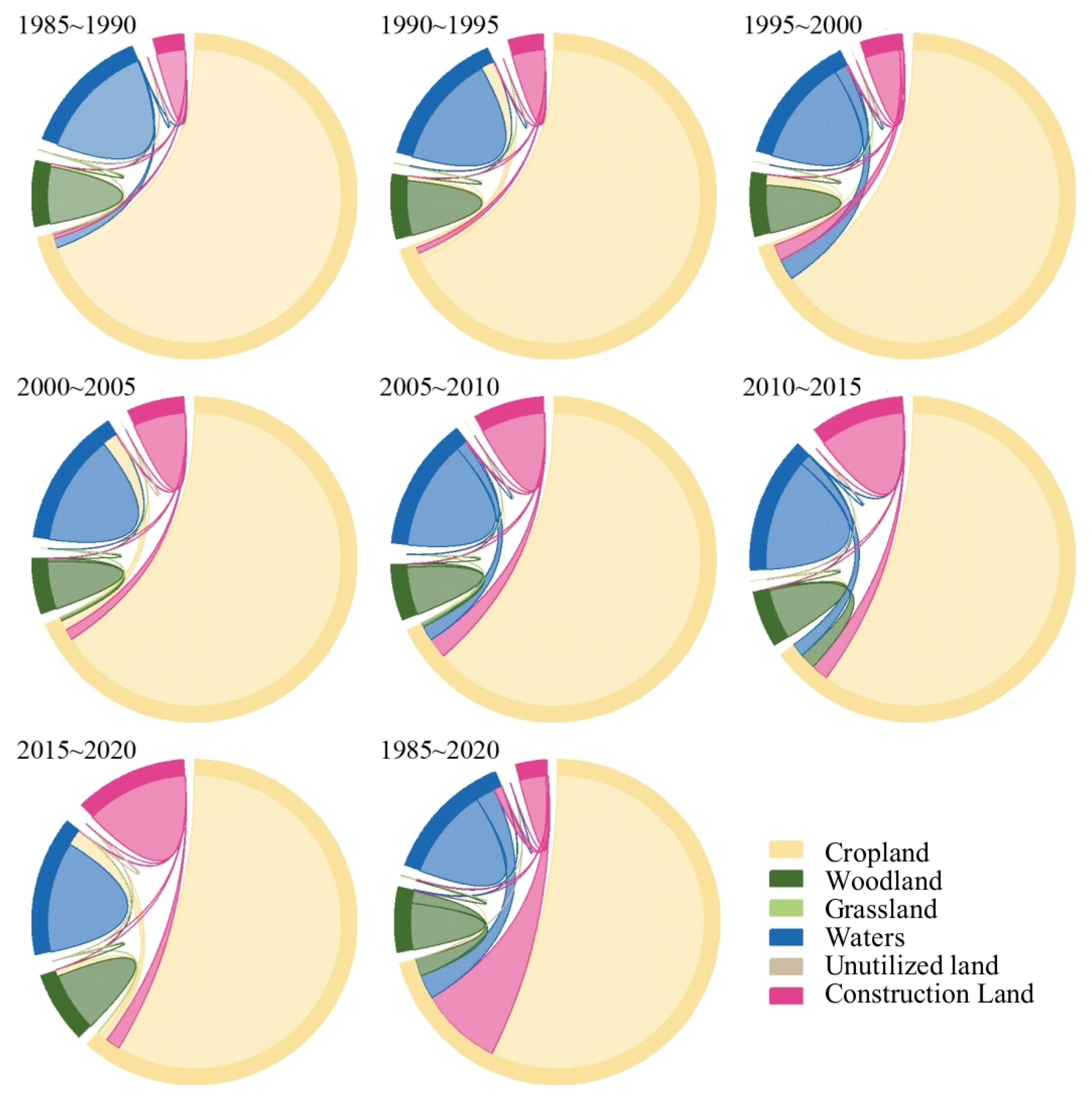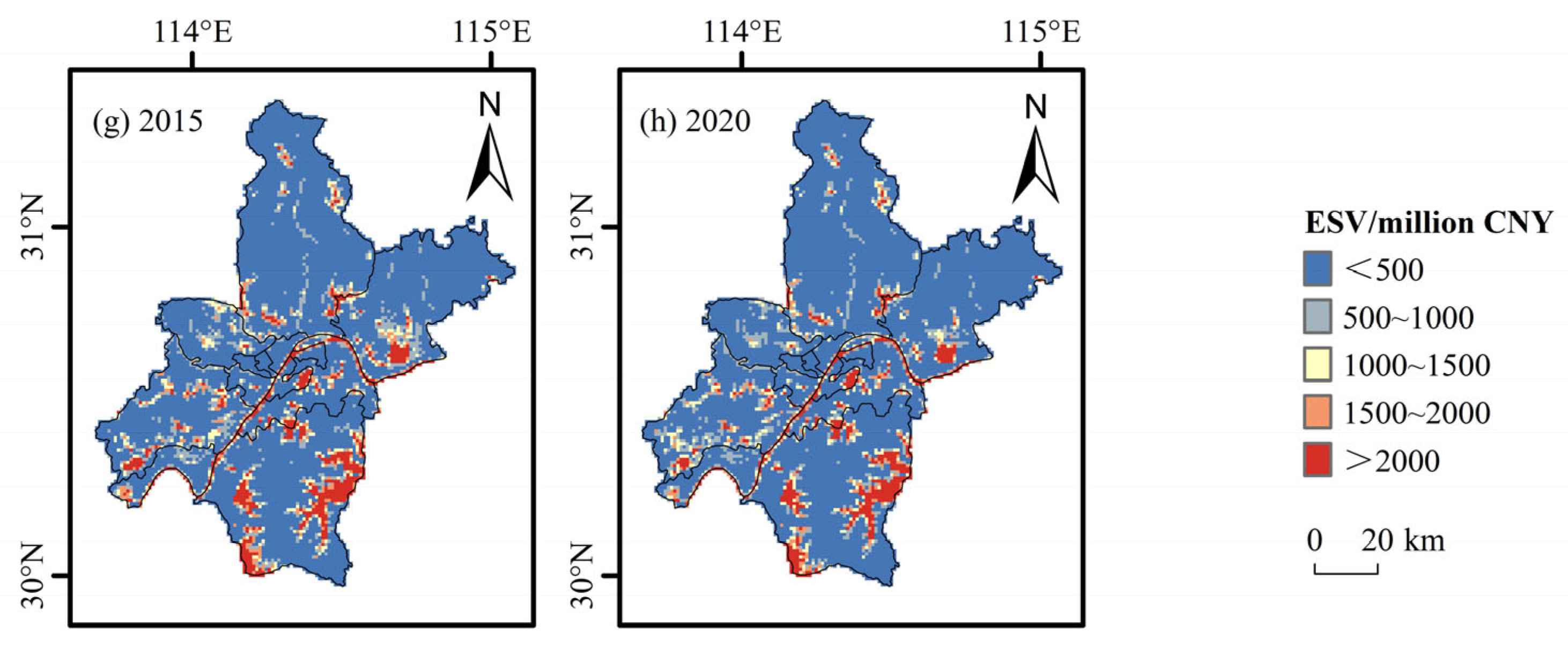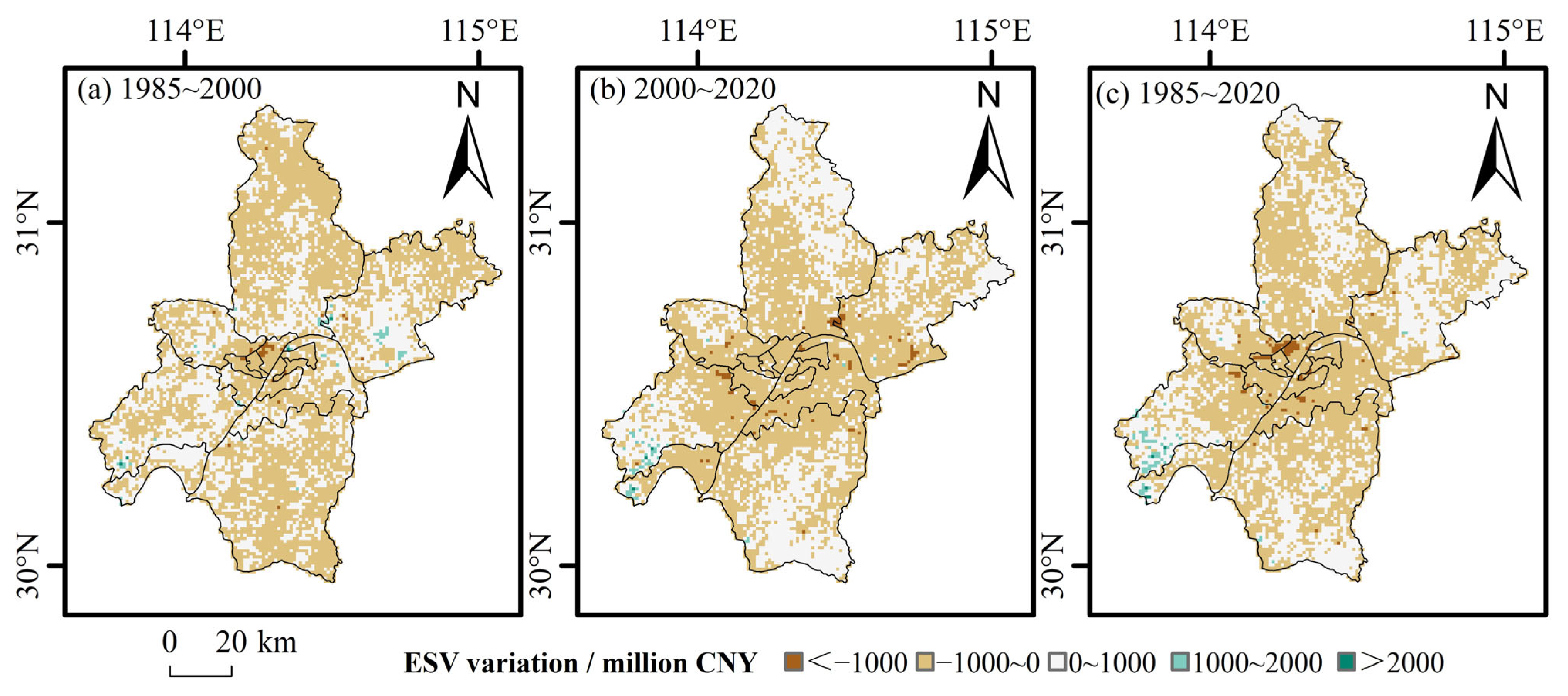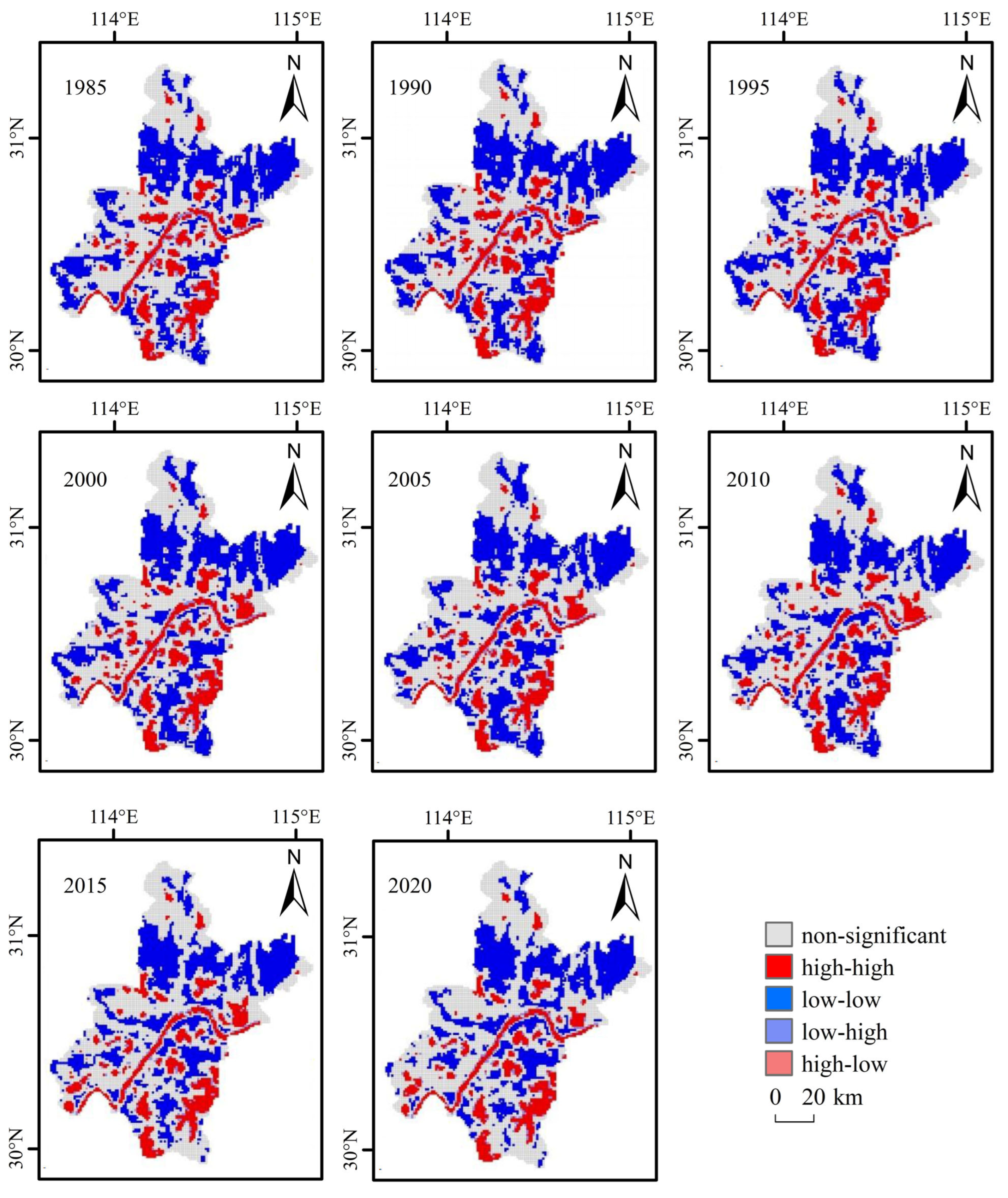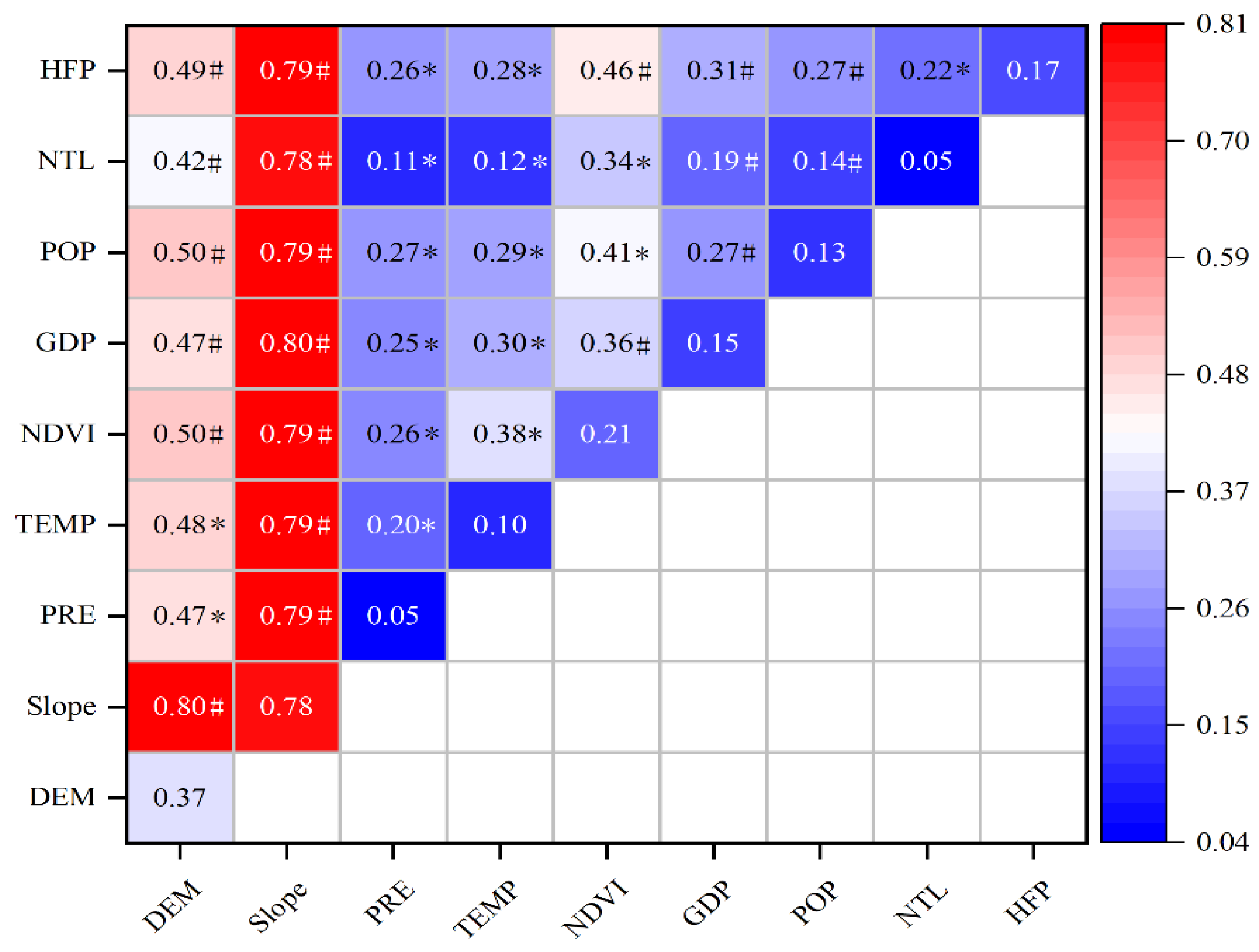5.1. Discussion
This study systematically explored the spatiotemporal evolution and driving mechanisms of ESV in Wuhan from 1985 to 2020. Compared with the existing literature, the key innovations and findings of this study are detailed below.
(1) Regionalized ESV coefficients adjusted to local grain yield. We developed and applied locally adjusted equivalent factors based on regional grain yields to improve the contextual suitability of the ESV estimates for Wuhan. Although the citywide ESV total showed limited fluctuation over the 35-year period, cultivated land area continuously declined, whereas built-up land expanded markedly; in particular, ESV in the urban core exhibited a clear downward trend. These results indicate that rapid urbanization exerts a substantial disturbance on ecosystem service provision and confirm the feasibility of regionalized equivalent factors for tracking changes in ESV during urban expansion.
(2) Complementary use of Geodetector and GWR. Geodetector was used to identify dominant drivers and interaction types (e.g., “slope ∩ GDP” and “slope ∩ human footprint,” showing bivariate or nonlinear enhancement), whereas GWR revealed the local heterogeneity and the spatial distribution of positive and negative effects. The combined use of these two methods strengthens the explanatory power of the driving mechanisms and provides richer spatial details.
(3) Natural base-dominated socioeconomic factors are amplified via interactions. Under rapid urbanization, we quantitatively confirmed a mechanism in which natural drivers play a leading role, whereas socioeconomic drivers act as important auxiliaries whose interactions significantly increase the explanatory power. In water-network-dense urban areas, such as Wuhan, waterbodies and topography decisively influence ESV, whereas socioeconomic pressures can locally alter ESV spatial patterns, especially in the urban core and its expansion zones. Integrate an ESV-guided zoning regime into urban planning by using Geodetector and GWR outputs (e.g., high-q hotspots such as slope × GDP and slope×human footprint) to delineate conservation-priority, development-restriction, and controlled-development zones. In conservation zones, prohibit land-use conversion and high-intensity development and prioritize restoration of wetlands, riparian buffers, and contiguous forest/grassland; in restriction zones, apply slope-sensitive permitting and require ecological slope stabilization; in development zones, mandate low-impact development (LID), sponge-city measures, and compensatory offsets. Embed these spatial controls in master and detailed plans and align them with fiscal and institutional tools (ecological compensation funds, differentiated fees, development caps) to achieve net-neutral or net-positive ESV outcomes.
(4) The coupling effect of multiple factors significantly enhanced the explanation of spatial variation in ESV. Interaction detection revealed that the combined effect of any two factors was greater than the individual effects, with “double-factor enhancement” and “nonlinear enhancement” being the dominant types of interactions. For example, combinations such as “slope ∩ GDP” (q = 0.80), “slope ∩ human activity footprint” (q = 0.79), and “elevation ∩ slope” (q = 0.80) significantly contributed to spatial variation in ESV. This highlights the need for an integrated approach to land use and ecological protection strategies, where the combined impact of multiple factors is considered, to avoid bias from analyzing individual factors alone.
(5) GWR revealed driver heterogeneity and local characteristics. The DEM coefficients were mostly positive in marginal hilly/forest areas, indicating that higher terrain commonly sustains greater ecosystem services (e.g., water conservation, soil retention, and habitat functions). In contrast, the coefficients tended to be weak or negative in the low-lying plains that have been heavily developed, reflecting the different pathways by which topography and land use jointly affect service value. The local effect of slope on ESV varied spatially; slope had a positive effect in well-vegetated slope areas (promoting ecosystem functions), but its effect weakened or became negative in transformed or cultivated slopes, suggesting that influence of slope is mediated by land-use conversion and management measures (e.g., shelterbelts, terracing). Climate variable coefficients (precipitation and temperature) ranged from neutral to weakly signed spatially. In ecologically sensitive or water-source conservation zones, precipitation and favorable temperatures generally promoted ESV; however, in urbanized areas prone to runoff, flooding, or urban heat island effects, climate variables may be associated with negative outcomes. Overall, climate impacts should be interpreted together with land use and urban exposure risks.
The NDVI showed a strong positive relationship with ESV across most natural and semi-natural patches, especially near contiguous forest and wetland areas, confirming the robust positive role of vegetation cover in enhancing ecosystem services. However, in the urban core, the positive effect of NDVI was weakened or even reversed, likely because of the fragmentation and anthropogenic modification of green spaces, highlighting the importance of green-space configuration and patch size for service provision.
Socioeconomic and human activity factors (human footprint, GDP, population density, and night-time lights) generally exhibited negative coefficients in the city and industrial/densely populated clusters, indicating that intensified human activity strongly suppresses ESV through land occupation, artificial surface coverage, pollution, and ecological fragmentation. In a few peri-urban or ecologically and economically coupled zones, some socioeconomic coefficients were weakly positive or neutral, suggesting that, under specific conditions, economic activity can coexist with, or even support, ecological protection.
(6) Limitations:
Service and supply side coverage: This study relied on land-use categories and a set of equivalent factors and does not cover all refined ecosystem service types (e.g., specific cultural services or detailed urban microclimate regulation). We did not explicitly incorporate constraints, such as pollution loads or water quality metrics.
Uncertainty from spatial resolution: Spatial resolution can introduce systematic bias through mixed-pixel effects, classification errors, and edge smoothing, particularly around waterbodies and urban boundaries. Although data sources and potential errors are discussed in the Materials and Methods section, the uncertainty introduced by the resolution has not yet been quantitatively assessed.
(7) Comparison with Studies in Other Regions
This study shares several conclusions with existing research conducted in China and abroad. For instance, Costanza et al. (1997) and subsequent studies have consistently emphasized the critical role of natural foundations in shaping ecosystem service value (ESV) [
11]. At both regional and urban scales (e.g., studies in the middle reaches of the Yangtze River, the Central Yunnan urban agglomeration, as well as Mediterranean and mountainous regions), natural topography and vegetation are commonly identified as dominant contributors to ecosystem service provision, while urban expansion has been shown to exert negative impacts on certain services. These findings have already been reviewed in the Introduction and References of this manuscript.
Nevertheless, certain differences emerge. Compared with arid and semi-arid regions, Wuhan—characterized as a subtropical city with a dense water network—exhibits a higher proportion of hydrological and regulatory services in its ESV composition, with aquatic ecosystems contributing significantly. This highlights the need to prioritize waterbody and wetland conservation in local governance strategies. Furthermore, in contrast to some developed metropolitan areas, where ecosystem service losses are more strongly associated with industrial pollution and externalities, changes in Wuhan’s ESV are more evidently driven by land-use conversion (e.g., cropland to construction land), resulting in spatial substitution effects.
5.2. Conclusions
Based on the results of this study, we draw the following conclusions:
(1) From 1985 to 2020, Wuhan’s total ecosystem service value (ESV) fluctuated around CNY 38.0 billion, with a cumulative decline of about CNY 1.024 billion and an average of CNY 38.158 billion. Water bodies contributed the most to ESV, followed by croplands and forests. The ESV structure remained stable, dominated by regulating services (over 91%), while the other three categories together accounted for less than 10%. The overall fluctuation and structural characteristics suggest that, even amid rapid urbanization, ESV dynamics were still largely shaped by natural conditions.
(2) Spatially, ESV in the urban core showed a clear downward trend, with low-value zones expanding outward from the center, while high-value zones were concentrated around the Yangtze and Han rivers. The global Moran’s I consistently remained above 0.70 (p < 0.01), indicating significant positive spatial autocorrelation. “High–high” clusters were mainly located in water-rich areas, whereas “low–low” clusters were concentrated in urban expansion zones.
(3) Geodetector results revealed that natural factors (slope, elevation, and NDVI) were the dominant drivers of ESV, while socioeconomic factors (human footprint, GDP, and population) also had significant but relatively smaller effects. Interactions between natural and human factors showed enhancement effects, highlighting their coupled role in shaping ESV patterns.
(4) Results of the GWR model demonstrated that regression coefficients of the driving factors varied in both direction and magnitude across subregions, indicating significant spatial nonstationarity. Natural conditions supported ESV in peripheral areas, whereas concentrated socioeconomic activities in the urban core generally reduced it, reflecting strong spatial heterogeneity in driving mechanisms.
(5) Overall, changes in Wuhan’s ESV were primarily driven by natural factors. However, in densely populated and economically developed urban cores, socioeconomic drivers significantly amplified their influence through interactions with natural factors, resulting in pronounced spatial heterogeneity. To maintain and enhance ecosystem services, sustainable planning should prioritize the protection of water bodies, croplands, and forests, and incorporate ESV-oriented zoning into urban planning. Measures such as wetland and riparian restoration, slope-sensitive controls, and low-impact development should be combined with financial and institutional instruments to achieve net-neutral or net-positive ESV outcomes.
